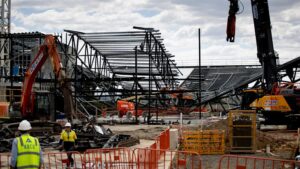
In a significant move reflecting the shifting dynamics of the global banking sector, National Australia Bank (NAB) announced the elimination of 410 jobs within its technology and enterprise operations division. This decision, revealed on Wednesday, is part of the bank’s broader strategy to optimize costs by expanding its workforce in countries with lower wage structures, such as Vietnam and India. The Finance Sector Union, representing the affected employees, disclosed that NAB plans to create 127 new roles overseas.
The announcement comes on the heels of a similar move by ANZ, which declared plans to cut 3,500 jobs. The back-to-back job cuts have sparked criticism from the Finance Sector Union, with its national president Wendy Streets condemning the sector’s approach. “Two banks in two days slashing jobs, it’s shameful,” she stated. “Profits in their billions, jobs in the bin, banks are showing open contempt for their own people.”
ASX Market Performance and Economic Indicators
Meanwhile, the Australian Securities Exchange (ASX) showed modest gains, with the ASX 200 index edging up by 0.1% to 8,815 points as of midday. This slight increase was primarily driven by gains in the banking sector, which counterbalanced losses in mining and gold stocks. The Australian dollar also saw a minor uptick, rising 0.2% to 65.94 US cents.
Globally, Wall Street indices showed positive momentum, with the Dow Jones, S&P 500, and Nasdaq all recording gains of around 0.4%. European markets presented a mixed picture, with the FTSE rising by 0.2% while the DAX fell by 0.4%. Commodity markets saw Brent crude oil rise by 0.8% to $66.91 per barrel, while iron ore prices increased by 1% to $106.50 per tonne.
Retail Sector Challenges and Responses
In the retail sector, Ritchies IGA is contemplating store closures in Victoria following a surge in retail crime. This development highlights the growing concern over workplace safety, prompting retailers like Bunnings and Woolworths to implement body-worn cameras for staff. The Australian Retailers Association is advocating for nationwide workplace protection orders to curb repeat offenses.
Iron Ore Market Dynamics
Iron ore futures experienced a decline due to profit-taking and weaker-than-expected inflation data from China, the world’s largest consumer of iron ore. The most-traded January iron ore contract on China’s Dalian Commodity Exchange saw a slight dip, while the Singapore Exchange’s benchmark October iron ore contract fell by 0.56%.
According to Steven Yu, a senior analyst at Mysteel, “The market direction is currently not clear enough and price movement was mainly driven by expectations, so it’s normal to see some downward correction following a price rally.” Despite the current dip, demand is expected to improve as Chinese steelmakers resume production after a military parade in Beijing.
Global Mining and Energy Developments
In the mining sector, Iluka Resources announced a suspension of production at its Cataby mine and Synthetic Rutile Kiln 2 in Western Australia due to subdued demand for mineral sands. This decision led to a significant drop in its share price, marking the largest intraday percentage fall since March 2020.
On the energy front, oil prices rose following an Israeli military strike on Hamas leadership in Doha, Qatar. Although the attack initially caused a spike in oil prices, they later stabilized as diplomatic assurances were made to prevent further escalation. “Both the US and Qatar have made it clear they are not seeking further escalation,” noted Jorge Leon, head of geopolitical analysis at Rystad Energy.
Implications and Future Outlook
The job cuts at NAB and ANZ reflect a broader trend in the banking sector towards cost optimization and technological advancement. As artificial intelligence and digital transformation continue to reshape the industry, further job reductions may be anticipated. Analysts like Matthew Haupt from Wilson Asset Management suggest that banks are increasingly looking to streamline operations and reduce costs associated with traditional roles.
In the commodities market, the fluctuating prices of iron ore and oil are indicative of the complex interplay between geopolitical events and economic indicators. As global markets continue to adapt to these changes, stakeholders will be closely monitoring developments in China, a key player in both the mining and energy sectors.
Overall, the current economic landscape presents both challenges and opportunities for businesses and investors. As companies navigate these changes, the focus will likely remain on balancing cost efficiency with strategic growth initiatives.







